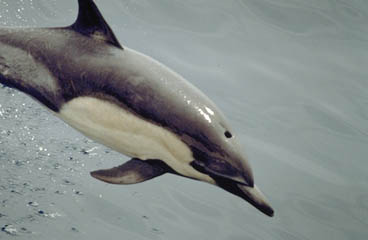|
Common Dolphin (Delphinus delphis) - Wiki
| 제목: | Common Dolphin (Delphinus delphis) - Wiki
| |

| 해상도: 368x240
파일크기: 14752 Bytes
등록시간: 2007:09:24 04:21:35
|
Common dolphin
From Wikipedia, the free encyclopedia
[Photo] Common Dolphin (Delphinus delphis) from http://nmml.afsc.noaa.gov/gallery/cetaceans/dd-14_comdolphin.htm Author NOAA, Scott Hill
The Common Dolphin is the name given to up to three species of dolphin making up the genus Delphinus.
Prior to the mid-1990s, most taxonomists only recognised one species in this genus, the Common Dolphin Delphinus delphis. Modern cetologists usually recognise two species - the Short-beaked Common Dolphin, which retains the systematic name Delphinus delphis, and the Long-beaked Common Dolphin Delphinus capensis. Despite its name the common dolphin is not the dolphin of popular imagination - that distinction belongs to the Bottlenose Dolphin, largely due to the television series Flipper.
Differentiating species
Despite the historic practice of lumping the entire Delphinus genus into a single species, these widely distributed dolphins exhibit a wide variety of size, shape and colour. Indeed over the past few decades over 20 distinct species in the genus have been proposed. Scientists in California in the 1960s concluded that there were two species - the long-beaked and short-beaked. This analysis was essentially confirmed by a more in-depth genetic study in the 1990s. This study also suggested that a third species (D. tropicalis, common name usually Arabian Common Dolphin), characterized by an extremely long and thin beak and found in the Red Sea and Indian Ocean, might be distinguished from the long-beaked species. The current standard taxonomic works recognize this as just a regional variety.
Distribution
The common dolphin is widely distributed in temperate, sub-tropical and tropical waters throughout the world in a band roughly spanning 40 degrees south to 50 degrees north. The variation in make-up described above from one population to the next suggested little interaction between distinct groups The species typically prefer enclose bodies of water such as the Red and Mediterranean Seas. Deep off-shore waters and to a lesser extent over continental shelves are preferred to shallow waters. Some populations may be present all year round, others appear to move in a migratory pattern. Preferred surface water temperature is 10-28 degrees Celsius. The sum population is unknown but numbers in the hundreds of thousands.
Behaviour
Common dolphins travel in groups of around 10-50 in number and frequently gather into schools numbering 100 to 2000 individuals. These schools are generally very active - groups often surface, jump and splash together. Typical behaviour includes breaching, tail-slapping, chin-slapping, bow-riding and porpoising.
The dolphins have been seen to mix with other cetaceans such as other dolphins in the Yellowfin tuna grounds of the eastern Pacific and also schools of Pilot Whales. An intriguing theory suggests that dolphins 'bow-riding' on very large whales was the origin of bow-riding on boats.
The gestation period is about 11 months and the calving period is between one and three years. Sexual maturation occurs at five years and longevity is twenty to twenty-five years. These figures are subject to large variation across different populations.
Conservation
Common dolphins face a mixture of threats due to human influence. Populations have been hunted off the coast of Peru for use as food and shark bait. In most other areas the dolphins have not been hunted directly. Several thousand individuals have been caught in industrial trawler nets throughout their range. Common dolphins were abundant in the western Mediterranean Sea until the 1960s but occurrences there have tailed off rapidly. The reasons are not well understood but are believed to be due to extensive human activity in the area. In the U.S. they are a protected species and sometimes are caught by accident in some trawler nets as bycatch, though despite this they are still quite common throughout their range.
http://en.wikipedia.org/wiki/Common_dolphin
| The text in this page is based on the copyrighted Wikipedia article shown in above URL. It is used under the GNU Free Documentation License. You may redistribute it, verbatim or modified, providing that you comply with the terms of the GFDL. |
|
댓글 |
|---|
| | 손님 |
|
Scientific Name: Delphinus delphis Linnaeus, 1758
Common Names:
English – Short-beaked Common Dolphin, Short-beaked Saddleback Dolphin, Saddle-backed Dolphin, Atlantic Dolphin, Pacific Dolphin
French – Dauphin commun
Spanish – Delfín Común, Delfín Común |
^o^
동물그림창고 똑똑전화 누리집
^o^
|
|
|